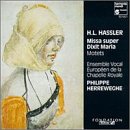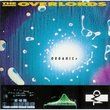| All Artists: Hans Leo Hassler, Leonhard Lechner, Philippe Herreweghe, Chapelle Royale Title: Hassler: Missa I super Dixit Maria - Motets - Vater unser im Himmelreich ~ Lechner: Si bona suscepimus / Herreweghe Members Wishing: 0 Total Copies: 0 Label: Harmonia Mundi Fr. Release Date: 12/22/1992 Genres: Special Interest, Pop, Classical Styles: Vocal Pop, Opera & Classical Vocal Number of Discs: 1 SwapaCD Credits: 1 UPCs: 093046140120, 3149025056238 |
Search - Hans Leo Hassler, Leonhard Lechner, Philippe Herreweghe :: Hassler: Missa I super Dixit Maria - Motets - Vater unser im Himmelreich ~ Lechner: Si bona suscepimus / Herreweghe
 | Hans Leo Hassler, Leonhard Lechner, Philippe Herreweghe Hassler: Missa I super Dixit Maria - Motets - Vater unser im Himmelreich ~ Lechner: Si bona suscepimus / Herreweghe Genres: Special Interest, Pop, Classical
Hans Leo Hassler was roughly contemporary with Palestrina and wrote in a similarly transparent style. Though he was Lutheran, he set numerous Latin texts, including the Mass. The Missa super Dixit Maria is a "parody" base... more » |
Larger Image |
CD DetailsSynopsis
Amazon.com Hans Leo Hassler was roughly contemporary with Palestrina and wrote in a similarly transparent style. Though he was Lutheran, he set numerous Latin texts, including the Mass. The Missa super Dixit Maria is a "parody" based on Hassler's famous motet Dixit Maria ad angelum. That motet isn't included here, unfortunately, but you can clearly hear its themes recurring in the various Mass movements. The motets on this disc include several penitential items with a striking chromaticism Palestrina wouldn't have touched. Vater unser, a setting of Luther's versification of the Lord's Prayer, seems dull in this company. That hardly matters--Philippe Herreweghe's rendition of the Mass is jaw-droppingly beautiful, more than worth the price of the CD. --Matthew Westphal Similar CDs
|
CD ReviewsHassler is alltogether underrepresented Guy Cutting | 06/10/2000 (5 out of 5 stars) "Hassler suffers from a bit of historical misfortune. He writes relatively late in the Renaissance when numerous changes are taking place. But more importantly he is German. Although nothing in Lutheran though explicity prohibits settings of Catholic texts, Hassler was undoubtedly influenced by the changing culture. So all in all he is not thought of as holding the central place in music as, for example, Palestrina is. But he is a composer of the highest order. Gramophone's review of this recording will tell you that the mass's "austerity does not convey deliberate restraint, but rather a certain pedestrian lack of imagination." The mass is largely homophonic, but the Kyrie and Agnus Dei, which are not, will tell you that Hassler lacks nothing in imagination. The Lutheran influence should not be forgetten - austerity is central. This spirit is reflected in Hassler's setting of "Vater unser im Himmelrich" - poetic texts which use the Lord's prayer as a basis. The pieces are polyphonic, but demonstrate a captivating restrain which encourages introspection and devotion. The motets on this disc display an astonishing range of compositional technique. I am not familiar with Lechner (with, of course, the exception of the one motet recorded here) but his composition reflects Hassler's teaching - Lechner shows himself to be yet another composer who deserves more recognition. Recommended..." There's only the MP3 available now... Giordano Bruno | Wherever I am, I am. | 12/11/2008 (5 out of 5 stars) "... although the CD is being offered at piratical prices!
There are reasons to be skeptical of this CD, the first being that you may never have heard of Hans Leo Hassler. Second, Herreweghe is essentially a Baroque specialist, whose performances from Schuetz to Bruckner are unsurpassed, but Baroque-niks often do odd things to polyphony. The good news is that Herreweghe conducts Hassler as if polyphony were his first language. High Renaissance mensural notation - sometimes called "white note" because of the empty squares and circles that represent pitches - was and is remarkably eloquent in telling us about the composer's rhythmic intentions. People who declare that 'we can't know what it sounded like' just haven't studied the original notation well enough. Modern conductors of this repertoire can be divided into two classes: the ones who perform from modern transcriptions and the ones who at least examine facsimiles of the originals and prepare their own scores for the singers. Believe it or not, I can almost always hear the difference in the performances. Herreweghe has examined deeply. White notation has no bar lines. The highest-level unit of counting is the implicit tactus, which is always ONE, a long unit of time normally equivalent to a square note with a tail. Skilled choirs didn't need a conductor as such, but there are accounts and pictures suggesting that 'someone' might have held the tactus on occasion by a stiff up-and-down arm movement. The tactus was sometimes established by taking one's pulse; if so, Herreweghe's health must be excellent since his pulse would be between 50 and 60 per minute. At the beginning of a score, there was a time signature - a circle or a C shape - indicating the tempus, that is, the division of the implicit tactus of ONE into THREE or TWO. THREE was called "perfect", since three-in-one represented the Holy Trinity. Therefore, TWO was called "imperfect." The circle or C might be slashed or contain a dot; the presence or absence of such marks indicated the "prolation", that is the basic division of the tempus once again into units of three-in-one or two-in-one. Thus a perfect tempus and a perfect prolation would be 1:3:3. An imperfect tempus and a perfect prolation would be 1:2:3. A musicologist might transcribe the latter as 6/8, but that would be misleading since it would start from the smallest unit of time whereas the white-note always started from the largest. A conductor using only the rhythmic expression of the transcription would "beat" time conspicuously, often so conspicuously that the listener might 'hear' bar-lines and down-beats where there shouldn't be any. White-note also had very subtle means of expressing rhythmic changes and polyrhythmic passages, by way of Coloration, so-called because the actual notes on parchment would be colored red instead of black, or else the white-note shapes would be blackened, eventually mutating into modern notational conventions which we call "black note." Singers had to be very expert in these conventions, since one voice might be singing in coloration while another sang in the basic tempus and prolation. Remember that nodody could be reading or conducting from full score; there were only part-books. Some original manuscripts - large books placed on a lectern for use - had the typical four parts spread over two open pages but facing different edges of the page so that singers could stand around the lectern. Many white-note manuscripts are beautiful works of calligraphic art, with miniature paintings. It was surely a visual treat to be a singer in a 16th or 17th C choir. The whole point is that a performance of Renaissance and German Baroque vocal music must have sublime rhythmic suppleness and independence of rhythmic "rhetoric" in every voice/part. That's an ideal achieved consistently only by the best one-on-a-part ensembles such as The Clerks' Group and The Orlando Consort...and by Herreweghe with his Ensemble de la Chapelle Royale. Though Hassler was a devout Lutheran, the first Lutheran to study in Catholic Venice, the mass recorded here is a traditional Latin mass, as are all the motets, but the final composition is unique: a setting of the Lutheran hymn Vater Unser in Himmelreich, with all of its verses set as a linked series of polyphonic chorales, a very serene and otherworldly chain of variations which sound very much like JS Bach more than a hundred years early." |

 Track Listings (21) - Disc #1
Track Listings (21) - Disc #1


